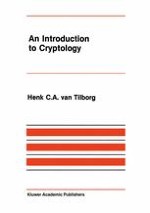1988 | OriginalPaper | Buchkapitel
Huffman Codes
verfasst von : Henk C. A. van Tilborg
Erschienen in: An Introduction to Cryptology
Verlag: Springer US
Enthalten in: Professional Book Archive
Aktivieren Sie unsere intelligente Suche, um passende Fachinhalte oder Patente zu finden.
Wählen Sie Textabschnitte aus um mit Künstlicher Intelligenz passenden Patente zu finden. powered by
Markieren Sie Textabschnitte, um KI-gestützt weitere passende Inhalte zu finden. powered by
It is clear from the previous chapter (in particular from (4.5) and (4.6)) that the security of a cryptosystem can be increased by reducing the redundancy in the plaintext. In Example 4.1 such a reduction has been demonstrated. In this chapter we shall describe a general method for what is called data compression or source coding. Let a (plaintext) source S output independently chosen symbols from the set {m1,m2, …, mn}, with respective probabilities p1, p2, …, pn. A symbol mi, 1 ≤ i ≤ n, will be encoded into a binary string ci of length li.The set {c1,c2, …, cn} is called a code C for the source S. The idea of data compression is to use such a code that the expected value of the length of the encoded plaintext is minimal. Since the output symbols are independent we have to minimize the expected length per symbol (5.1)$$ L = \sum\limits_i -1^n p_il_i$$ over all possible codes C for the source S. There is however an additional constraint. One has to be able to retrieve the individual messages from the concatenation of the succesive codewords. Not every code has this property. Indeed let C = {0,01, 10}. The sequence 010 can be made in two ways: 0 followed by 10 and 01 followed by 0. This ambiguity has to be avoided.
